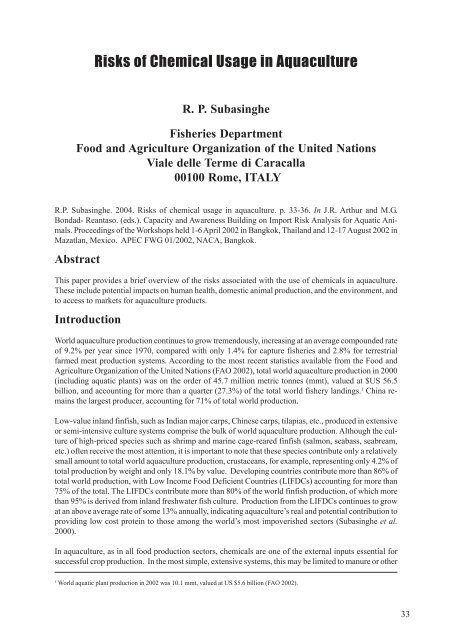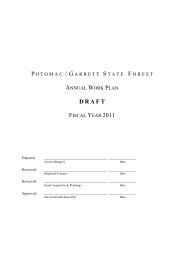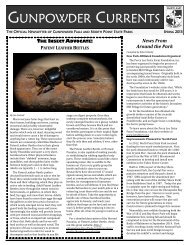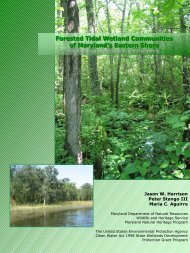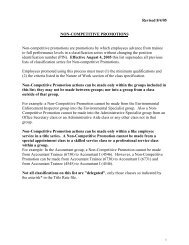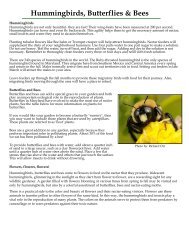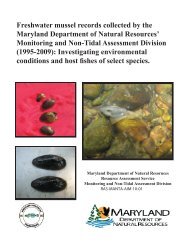NAca Section 2.pmd - Maryland Department of Natural Resources
NAca Section 2.pmd - Maryland Department of Natural Resources
NAca Section 2.pmd - Maryland Department of Natural Resources
You also want an ePaper? Increase the reach of your titles
YUMPU automatically turns print PDFs into web optimized ePapers that Google loves.
Risks <strong>of</strong> Chemical Usage in Aquaculture<br />
R. P. Subasinghe<br />
Fisheries <strong>Department</strong><br />
Food and Agriculture Organization <strong>of</strong> the United Nations<br />
Viale delle Terme di Caracalla<br />
00100 Rome, ITALY<br />
R.P. Subasinghe. 2004. Risks <strong>of</strong> chemical usage in aquaculture. p. 33-36. In J.R. Arthur and M.G.<br />
Bondad- Reantaso. (eds.). Capacity and Awareness Building on Import Risk Analysis for Aquatic Animals.<br />
Proceedings <strong>of</strong> the Workshops held 1-6 April 2002 in Bangkok, Thailand and 12-17 August 2002 in<br />
Mazatlan, Mexico. APEC FWG 01/2002, NACA, Bangkok.<br />
Abstract<br />
This paper provides a brief overview <strong>of</strong> the risks associated with the use <strong>of</strong> chemicals in aquaculture.<br />
These include potential impacts on human health, domestic animal production, and the environment, and<br />
to access to markets for aquaculture products.<br />
Introduction<br />
World aquaculture production continues to grow tremendously, increasing at an average compounded rate<br />
<strong>of</strong> 9.2% per year since 1970, compared with only 1.4% for capture fisheries and 2.8% for terrestrial<br />
farmed meat production systems. According to the most recent statistics available from the Food and<br />
Agriculture Organization <strong>of</strong> the United Nations (FAO 2002), total world aquaculture production in 2000<br />
(including aquatic plants) was on the order <strong>of</strong> 45.7 million metric tonnes (mmt), valued at $US 56.5<br />
billion, and accounting for more than a quarter (27.3%) <strong>of</strong> the total world fishery landings. 1 China remains<br />
the largest producer, accounting for 71% <strong>of</strong> total world production.<br />
Low-value inland finfish, such as Indian major carps, Chinese carps, tilapias, etc., produced in extensive<br />
or semi-intensive culture systems comprise the bulk <strong>of</strong> world aquaculture production. Although the culture<br />
<strong>of</strong> high-priced species such as shrimp and marine cage-reared finfish (salmon, seabass, seabream,<br />
etc.) <strong>of</strong>ten receive the most attention, it is important to note that these species contribute only a relatively<br />
small amount to total world aquaculture production, crustaceans, for example, representing only 4.2% <strong>of</strong><br />
total production by weight and only 18.1% by value. Developing countries contribute more than 86% <strong>of</strong><br />
total world production, with Low Income Food Deficient Countries (LIFDCs) accounting for more than<br />
75% <strong>of</strong> the total. The LIFDCs contribute more than 80% <strong>of</strong> the world finfish production, <strong>of</strong> which more<br />
than 95% is derived from inland freshwater fish culture. Production from the LIFDCs continues to grow<br />
at an above average rate <strong>of</strong> some 13% annually, indicating aquaculture’s real and potential contribution to<br />
providing low cost protein to those among the world’s most impoverished sectors (Subasinghe et al.<br />
2000).<br />
In aquaculture, as in all food production sectors, chemicals are one <strong>of</strong> the external inputs essential for<br />
successful crop production. In the most simple, extensive systems, this may be limited to manure or other<br />
1 World aquatic plant production in 2002 was 10.1 mmt, valued at US $5.6 billion (FAO 2002).<br />
33


